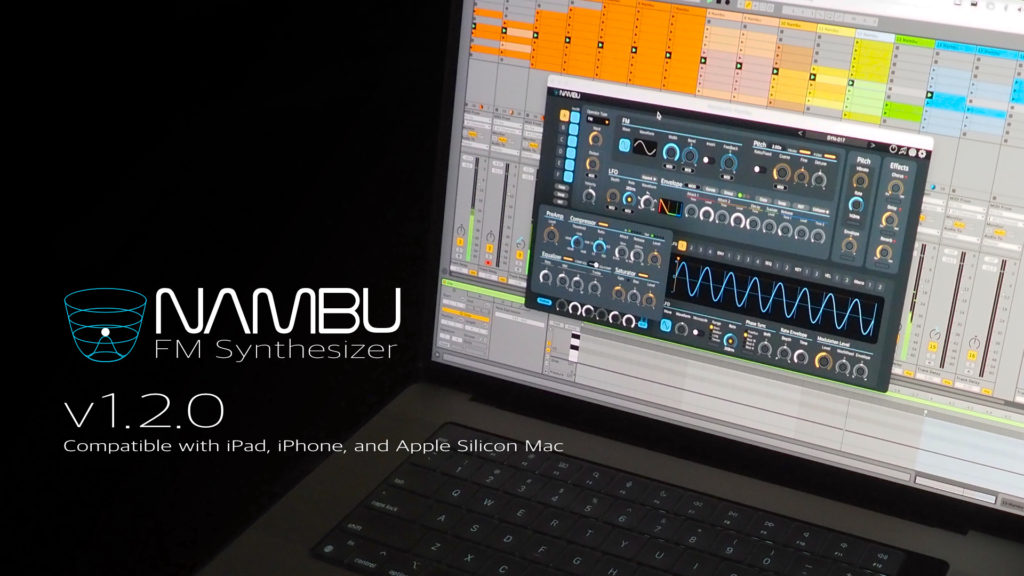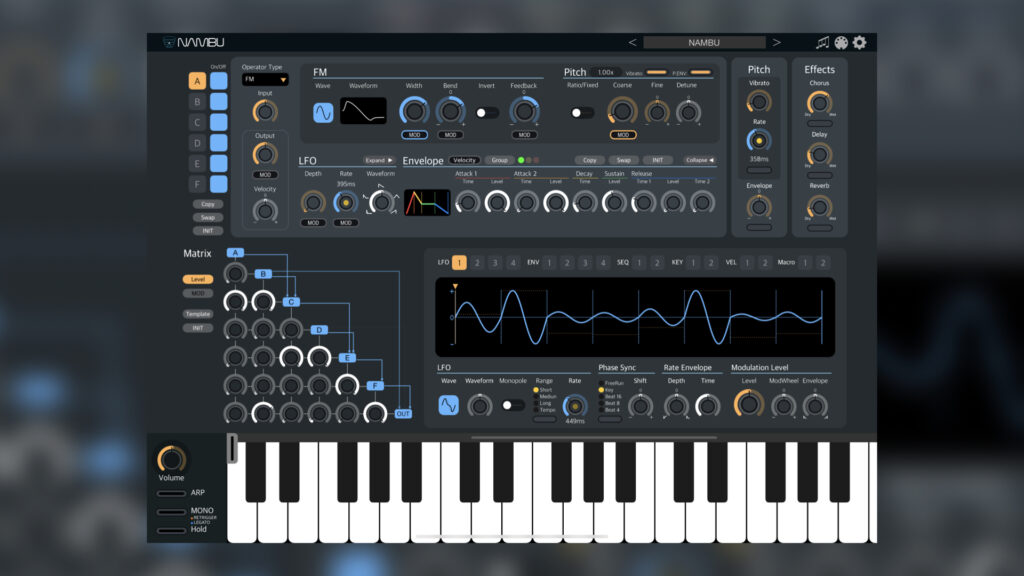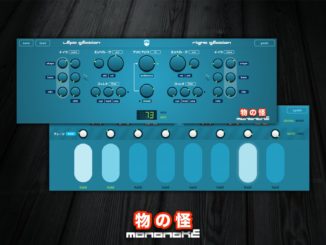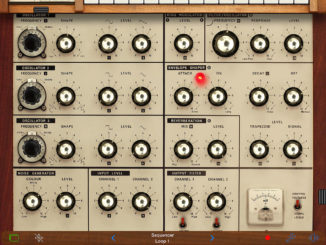iceWorks Nambu is a new 6-operator FM Synthesizer with a semi-modular engine made for exploring sonic territories beyond vintage FM synths.
As almost a fanboy of the developments of iceWorks (iceGear), I was waiting for this moment. Today, the first app by the highly talented Japanese developer is available as an AUv3 plugin for macOS.
Everything has a beginning. This makes Nambu a 6-operator FM Synthesizer that is strongly reminiscent of the concept of the Korg opsix. Filters, shaping options, various waveforms, modulator operators, and more. Big thanks for the macOS AUv3 version. As an iOS user, you can also download it for free from the AppStore on your compatible Mac.
I hope this is the beginning of many more iceWorks synths with AUv3 for macOS.
___________________________________________________________________________________________________
Article August 12th, 2022
When I started Synth Anatomy, iOS synths were absolutely unique and fascinating. New apps were constantly coming onto the market, bringing new possibilities to our mobile devices. Now in 2022, after over 8 years, we have reached the point where many users find their Synthesizer favorites. And almost everything should be covered in the field of synthesis even on iOS.
If an iOS synth app wants to inspire users in 2022, it has to be special and different. More of the same, users now have enough. The apps of the talented Japanese Satoshi Taneda aka iceWorks (iceGear Instruments). They always have features and concepts that have never been seen before on iOS. For me, they activate the “fascinating” trigger I’ve been missing on iOS a bit. The good news is iceWorks is back with a new synth app called Nambu.
iceWorks Nambu
With Nambu, Satoshi has published a semi-modular 6-operator FM Synthesizer with AUv3 plugins. A quick look at the features clearly shows where iceWorks got his inspiration. Probably on the Korg opsix, which also combines semi-modular with FM.
Nambu has six operators that can join together in a matrix. Each operator has 6 different operator types: FM, oscillator, noise, texture, resonator, and filter. And like in the opsix, each operator can have its own mode, so you can combine it wildly. You can choose between 32 different waveforms with various shaping parameters: width, bend, invert, and feedback.
The FM matrix mixer used is also special here. You can craft your own FM algorithms by combining operators; where I do I know the concept from? Mmmm. The developer ships the synth with 32 preset templates that serve as a starting point. You can, of course, also design more complex operator networks.
Then, you benefit from a huge modulation engine with 4 LFOs, 4 envelopes, 2 step sequencers, 2 keyboard scaling, 2 velocities, and 2 macros. And these are not anything but simple. For example, the LFO has various simple and complex waveforms with shaping parameters. The envelopes also support negative values which is a handy function in sound design.
Further, you can work with a fully customizable multi-effects processor with chorus, delay, and reverb to refine your sounds. There is also the best-known programmable iceWorks arpeggiator onboard.
And you can work with micro-tuning to change the equal temperament tuning scale to a different tuning.
First Impression
It’s clear where Satoshi got the idea for the new Nambu Synthesizer. I’m looking forward to taking a closer look at the synth. Even more so as an iceWorks synth release fan. A downer: you can’t use the app on macOS yet, I and many others would be happy about support for desktop.
iceWorks Nambu is available now for an introductory price of $14,99 (regl $17,99/21,99€) on the Apple AppStore. It runs as a universal app on iOS devices (iPhone/iPad) and supports AUv3. And now also macOS.
More information here: iceWorks






At 1:58 you can see a filter appear on the screen of the firste video.
And there is more: each operator seems to have 2 filters: one for its own output, and one for the feedback loop (second video)
And there is more: each operator seems to have 2 additional filters: one for its own output, and one for the feedback loop (second video). Looks like there are much more filters than in most FM synths.
Korg could have brought opsix to ipad too. At the very least the ipad pro can run it (since it has the same processor as mac that can run opsix native), but probably a whole bunch of them would be capable of running it.
Now they are no longer first. And I sincerely doubt opsix native for ipad would go for $15…
If this is just $15, why are VSTi’s selling for hundreds?
different market. No development + beta testing for two or three operation systems (Win, MacOS, Linux) And since apps reach a wider audience as an “app” than a VST that only attract musicians with a DAW knowing what a VST plugin is.
I think your first arguments are valid, but I cannot imagine that someone without any musical intentions would be interested in synth apps like this one. Maybe I am wrong.
You mean there is no development + beta testing for VSTi?
So, unlike VSTi, it implies there are far more people buying these iOS apps just for casual reasons?
There is but for a desktop plugin, you need to develop often a VST, VST3, AU, AAX… and all this needs time to be beta tested, etc. The accessibility is much more direct with apps than with plugins. Apps are in the app store. Anyone who buys a plugin knows what a plugin is, what a DAW is, etc. Anyone can install an app on their iPhone/iPad… in seconds. For a plugin, you need a DAW, etc. There are many iPhone/iPad user out there so these are potential customers, where the potential customers of a plugin is much smaller. Not sure if there are other factors but for me this is a good part of it why apps are much more cheaper.
iPad apps are much harder to pirate.
And impossible to resell.
And are rarely used in professional studios / live rigs.
Impossible to resell: well that would be the collapse of the entire iOS ecosystem. Apps are already super cheap, and then re-selling a $5 iOS app. lol
Talking about professional use: Jordan Rudess or Diego Tejeida (ex-Haken) uses iOS apps all the time on stage. I’m not a professional musician but I use two iPads and an iPhone in all my live performances, the synth as well as multi-effects processor for shaping my hardware devices.
If you know how to work with it, iOS a genius platform.
“If you know how to work with it, iOS a genius platform.
As an actual iOS app developer, this is probably the funniest statement Ive ever heard!
why? many people struggle to incorporate their iOS devices in the music setup. Many don’t know that you can simply route audio from synths to your DAW via the lightning or USB-C cable.
It’s important to note that you can only use the macOS AUv3 plugin on a Mac with an M1 or M2 processor. No plugin for you if you have an Intel Mac.
I applaud the developer for making the plugin available for use in macOS. There are many AUv3 iOS plugins where the developer has not made the plugin available for use in macOS.